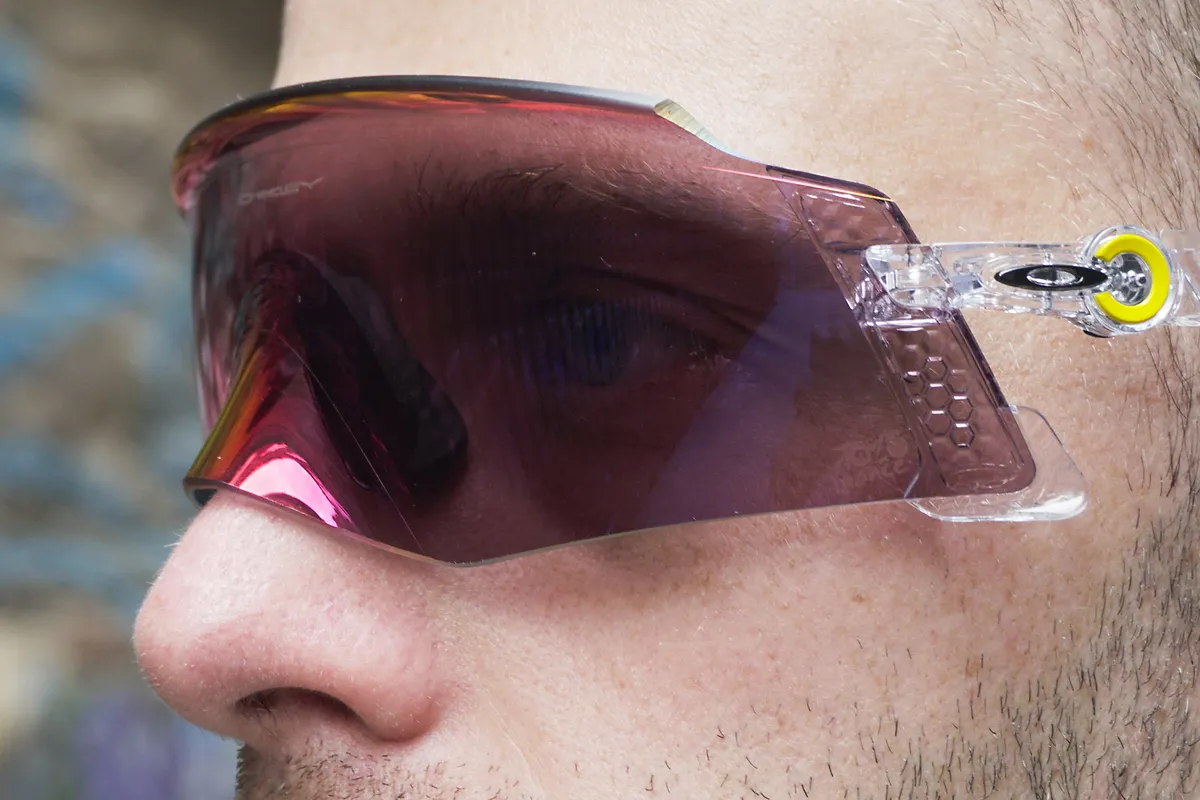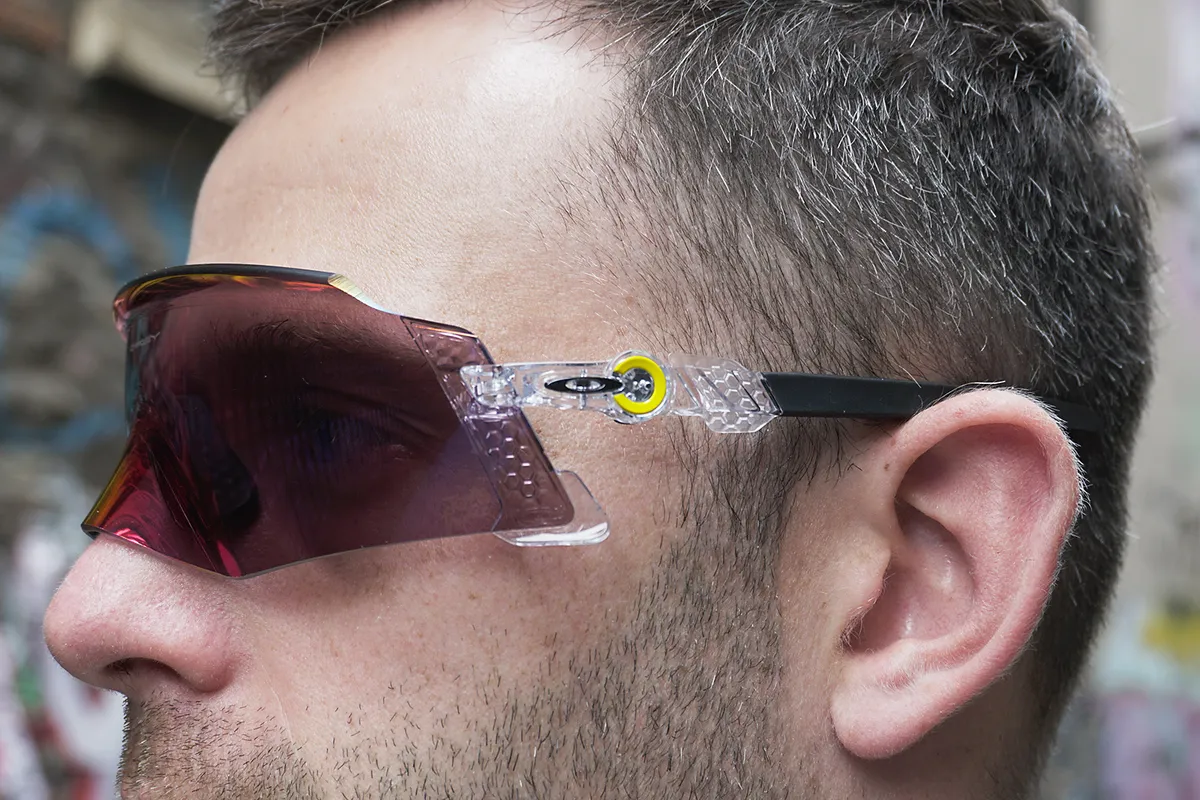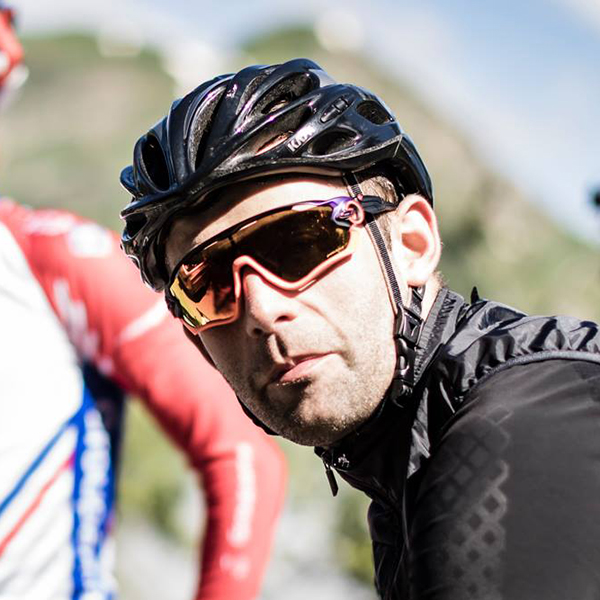Oakley's Kato sunglasses use a mask-like lens design that wraps around the rider’s face, complete with a moulded section for the nose and integrated nosepiece.
The cycling-specific sunglasses have impressed in testing, showing off the brand's well-earned reputation for optical clarity and comfortable fitting. However, the design will have its limitations if you don’t fit a certain shape, and the looks certainly aren't everyone’s cup of tea.
The Oakley Kato officially launched in 2021, and were worn by Mark Cavendish on his heroic return to the Tour de France that year.
The Manxman claimed four stages to tie Eddy Merckx’s record of 34 then, earning the green jersey in the process. But he was resplendent throughout in gold-lensed Oakley Kato sunglasses.
Oakley Kato sunglasses details and specifications

The Oakley Kato sunglasses feature a wraparound-style lens, featuring the brand’s Prizm optical technology.
Prizm tech is said to boost contrast and tailor the optics to suit certain situations. Prizm Road (as tested) is a common choice for road cyclists, as it’s claimed to help riders pick out shadows and textures as well as highlight colours and road markings.
Oakley has a habit of launching new colours alongside popular ones each season, but at the time of testing, seven standard varieties are available direct from the US brand:
- Prizm Road lens / Polished Black frame (20 per cent light transmission)
- Prizm Road Black lens / Grey Smoke frame (11 per cent light transmission)
- Prizm Trail Torch lens / Polished Black frame (35 per cent light transmission)
- Prizm Black lens / Polished Black frame (11 per cent light transmission)
- Prizm 24k lens / Polished Black frame (11 per cent light transmission)
- Prizm Sapphire lens / Polished Black frame (12 per cent light transmission)
- Prizm Dark Golf lens / Polished Black frame (22 per cent light transmission)
Each of these models retail for £245 / $298 / €275 / AU$386, while the actual model we tested – the Tour de France 2022 collection version – comes in at £265 / $323/ €295 / AU$396. These feature a clear frame with a neat yellow O ring to accompany the Prizm Road lenses.
The lens comes with claims of fitting to the contours of the face, providing “unparalleled optics and clarity of vision”. It features a lip on the top to guide air between the backside of the lens and the face.
The arms can also pivot at the O ring thanks to an adjustable clasp. This tilting mechanism can be used to provide a little more ventilation if needed, or it can be used to customise the fit of the sunglasses to the face.
The nosepiece lives behind the distinctive lens contour, with the mounting point for it directly attached to the backside of the lens. Oakley says it provides three different nosepieces to suit the rider’s nose shape.
The silicone material used for the nose piece is able to mould a little to the wearer’s nose shape, with the same material used at the arm socks to grip the head.
Oakley Kato sunglasses performance

Throughout testing, I’ve been impressed by the Katos, bringing a wide field of vision that is comparable to the brand’s fully framed Jawbreaker model.
Almost none of the world is obscured, and when I gazed where one would normally be looking when riding aggressively on the drops or with a stoop on the hoods, I often completely forgot I was wearing them.
There is a small amount of distortion around the nosepiece. The nosepiece itself is also visible if you happen to look sharply to the left or right.
However, as I got used to wearing the Katos, I was able to instinctively ignore both of these small issues.

The Prizm optics are outstanding, offering practically perfect clarity, while the contrast the Prizm Road lenses offer does make a difference versus lenses without it. Oakley claims it helps with picking out road textures, shadows and obstacles, and I can’t disagree.
If you live in sunnier climes than the UK (where my testing was done), you might be better off with the Prizm Road Black lenses, which offer lower light transmission.
Unlike with my favoured Jawbreakers (and the still-popular Radar), you can’t replace the lens on the Oakley Kato.
The bold looks are always going to be hit-or-miss.
Initially, I had reservations about the design, and having worn them for a while, I still can’t decide if I really like how I look in them or not.
Personally, I’ve grown used to them, and where initially I thought I might look a bit silly, I’m now more ambivalent. That’s a subjective matter though, and you may feel they’re right up your street.
If they’re not your style, there are plenty more to choose from if your heart is set on a pair of Oakleys.

The Kato sunglasses are said to fit best to those with wider faces and a higher nose bridge. My face isn’t notably wide, yet I found the rounded shape of the arm socks really helped to secure them to my head.
I experienced only a small amount of ‘jumping’ off my nose, but that was only when riding over rough roads at speed.
The supplied nosepiece rests comfortably on my quite high nose bridge, and I can’t recall a time that I had to push them back onto my face.
The overall orientation of the lens, plus its frameless design, also allows a good amount of air to flow down between the face and lens. I had no trouble with misting on the move in cooler conditions or when climbing.
I often have difficulty with sweat getting from my eyelashes onto sunglasses lenses (obscuring my vision when the inevitable marks are left), but the Katos are one of the very few sunglasses that I’ve used that I haven’t encountered that problem with.
I never found a compelling reason to use the adjustable mechanism to increase or decrease the lens tilt – the standard fit was fine for me. Experimenting with it, you’ll find the black cover on the inside of the yellow O lifts off, allowing some pivot in the frame (Oakley says up to 30 degrees).

You may find this useful if you need more ventilation or your face shape means you need the ‘breathing room’ it can give, but it’s a fiddly little mechanism requiring fingernails or a sharp implement to pry away.
It’s not practical to adjust on the move, so you’ll need to find your optimum setup then stick to it. I also found, once pried off, the black cover wouldn’t always easily click back into place.
As I type, I still can’t get the right-hand cover to fully recess again. It doesn’t affect performance out on the road though, so it’s an annoying niggle rather than a real problem.
You can’t adjust the positioning of the nose piece, but you can swap it for Oakley-supplied alternative sizes.
I occasionally needed to wipe away the greasy/sweaty marks left behind on the moulded nose section, but the problem is minimal as you can’t see through the nose contour part anyway. If you have a particularly large nose, this may be an issue, and I’d recommend trying them on before buying.
Oakley Kato sunglasses bottom line

The Oakley Kato are very competent performance cycling sunglasses. The looks may polarise opinion, but what niggles there are won’t be deal-breakers for most.
The Kato sunglasses comes with Oakley’s customary high price tag but that has never ordinarily been an obstacle to dedicated fans who want to own the latest model.
Product
| Brand | oakley |
| Price | 396.00 AUD,295.00 EUR,265.00 GBP,323.00 USD |
| Weight | 34.0000, GRAM (One size only) - |
Features
| Features | Sizes: One, three nose pieces supplied Colours: Prizm Road lens / Polished Black frame (20% light transmission) Prizm Road Black lens / Grey Smoke frame (11% light transmission) Prizm Trail Torch lens / Polished Black frame (35% light transmission) Prizm Black lens / Polished Black frame (11% light transmission) Prizm 24k lens / Polished Black frame (11% light transmission) Prizm Sapphire lens / Polished Black frame (12% light transmission) Prizm Dark Golf lens / Polished Black frame (22% light transmission) Prizm Road lens / 2022 Tour de France collection frame (20% light transmission) - tested |
